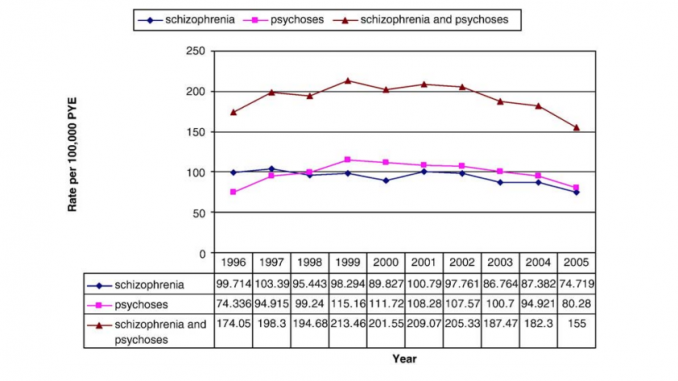
In terms of the model set out in the Introduction, the
expected rise in diagnoses of schizophrenia and psychoses did
not occur over a 10 year period. This study does not therefore
support the specific causal link between cannabis use and the
incidence of psychotic disorders based on the 3 assumptions
described in the Introduction. This concurs with other reports
indicating that increases in population cannabis use have not
been followed by increases in psychotic incidence (Macleod
et al., 2006; Arsenault et al., 2004; Rey and Tennant, 2002).
Assessing the impact of cannabis use on trends in diagnosed schizophrenia in the United Kingdom from 1996 to 2005
Martin Frisher, Ilana Crome, Orsolina Martino, Peter Croft, 2009
Cannabis schizophrenia – does it exist?
The incidence and prevalence of patients showing schizophrenic syndromes are unchanged or have even fallen while the use of cannabis has increased enormously. We must conclude that either previous schizophrenic illnesses have become much less common or that cannabis schizophrenia is rare and perhaps it may not even exist.
21 December 2002, David H. Marjot, BMJ
There was a steep rise in the prevalence of cannabis use in Australia over the past 30 years and a corresponding decrease in the age of initiation of cannabis use. There was no evidence of a significant increase in the incidence of schizophrenia over the past 30 years.
Drug Alcohol Depend. 2003 Jul 20;71(1):37-48.
Testing hypotheses about the relationship between cannabis use and psychosis.
Degenhardt L1, Hall W, Lynskey M.
In the largest study of its kind so far, we have shown that recreational cannabis users do not release significant amounts of dopamine from an oral THC dose equivalent to a standard cannabis cigarette. This result challenges current models of striatal dopamine release as the mechanism mediating cannabis as risk factor for schizophrenia.
Causal association between cannabis and psychosis: examination of the evidence.
Arseneault L1, Cannon M, Witton J, Murray RM. Br J Psychiatry. 2004
The current data do not support low to moderate lifetime cannabis use to be a major contributor to psychosis or poor social and role functioning in high-risk youth.
Prospective Study of Cannabis Use in Adolescents at Clinical High-Risk for Psychosis: Impact on Conversion to Psychosis and Functional Outcome
Andrea M. Auther, Ph.D., Danielle McLaughlin, M.A., Ricardo E. Carrión, Ph.D.,aPradeep Nagachandran, M.D., Christoph U. Correll, M.D., and Barbara A. Cornblatt, M.B.A., Ph.D. Psychol Med. 2012
“Cannabis use appears to have increased substantially amongst young people over the past 30 years, from around 10% reporting ever use in 1969–70, to around 50% reporting ever use in 2001, in Britain and Sweden. If the relation between use and schizophrenia were truly causal and if the relative risk was around five-fold then the incidence of schizophrenia should have more than doubled since 1970. However population trends in schizophrenia incidence suggest that incidence has either been stable or slightly decreased over the relevant time period.”
Psychological and social sequelae of cannabis and other illicit drug use by young people: a systematic review of longitudinal, general population studies
John Macleod, Rachel Oakes, Alex Copello, Ilana Crome, Matthias Egger, Mathew Hickman, Thomas Oppenkowski, Helen Stokes-Lampard, George Davey Smith, THE LANCET • Vol 363 • May 15, 2004 • p. 1585
Psychosis is not increasing & IQ levels are not dropping in spite of massive increases in cannabis use rates
We found no evidence to support an overall change in the incidence of psychotic disorder over time, though diagnostic shifts (away from schizophrenia) were reported.
Incidence of schizophrenia and other psychoses in England, 1950-2009: a systematic review and meta-analyses.
Kirkbride JB1, Errazuriz A, Croudace TJ, Morgan C, Jackson D, Boydell J, Murray RM, Jones PB. PLoS One. 2012
Conclusions
The age-specific incidence of schizophrenia among persons aged 16 to 25 years in Finland has decreased. A significant cohort effect was observed, suggesting that some risk factors for schizophrenia, probably operating early in life, have diminished in intensity. The effect of period was also significant and probably reflects changes in diagnostic criteria. The findings from this cohort-based study accorded with several period-based studies, thus strengthening evidence of a worldwide decline in the incidence of schizophrenia.
Decline in the Incidence of Schizophrenia in Finnish Cohorts Born From 1954 to 1965
Jaana M. Suvisaari, MD; Jari K. Haukka, PhD; Antti J. Tanskanen, BSc; et alJouko K. Lönnqvist, MD, PhDAuthor AffiliationsArticle Information Arch Gen Psychiatry. 1999;56(8):733-740. doi:10.1001/archpsyc.56.8.733 August 1999
